BY JEN VAUGHN – For anyone who has ever performed any improv, there is a simple rule: ‘Say Yes.’ Say yes to a situation when presented to you because your fellow troupe member has a story line. You can add even more “yes and…” The same rule applies to a game called Fiasco, which calls itself the ‘make your own Coen brothers film’ game. You create a story without props with high stakes, characters with high ambition and low impulse control AND with a traditional story structure. The first time I played was with Comics Journal editor and gaming partner Kristy Valenti and the heat was oppressive, adding to our Western setting. Center for Cartoon Studies professor and cartoonist (most notably for BERLIN), Jason Lutes, has taken the narrative he created with five CCS graduates and turned it into a 72 page full-color comic book called BINGO BABY.

The creators include five CCS graduates Donna Almendrala, Bill Bedard, Joseph Lambert, Amelia Onorato, and Denis St. John and Jason Lutes is their whip-cracking editor. It’ll be interesting to see this story that was created rather on the fly by creative storytellers and then coaxed into comic book page submission. Each of these young cartoonists are drawn to rich stories, no matter what genre or style. Based on the video, they draw a lot from the quiet mountain town of White River Junction, full of its share of characters from the meth addicts to the Vietnam War veterans to the bougie retirees to the dueling bingo venues crammed with hardcore players. You can do the ol’ Kickstarter pre-order now for only $10.
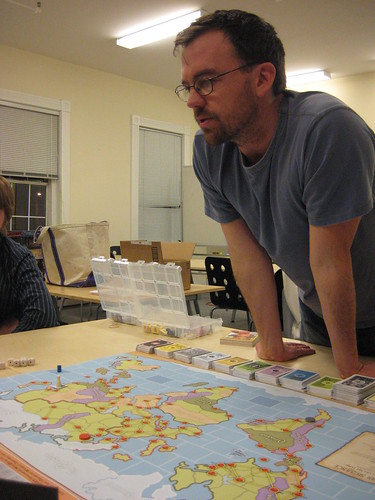
Lutes is known at the school for his board game nights. Wish there was a reward that included Lutes coming to YOUR board game night and teaching you a thing or two about wheat or stone trades. Rewards include the book itself, a shirt, hell—some original Lutes artwork!

—
Jen Vaughn is a Seattle-based cartoonist and marketing manager at Fantagraphics. CAVEAT: she’s played board games with all these creators and they are magnificent bastards.
Weird tales and comics naturally go together. From the days of pulp stories with enthralling illustrations, through EC’s Wertham-harried evocation of the fantastic and grotesque, to the heydays of Vertigo and Darkhorse, readers want to see an artist’s interpretation of the strange and bizarre. And the most exciting weird comics bring visual elements to the narrative that the reader could never have predicted or expected. Stephen Bissette has spent a great deal of his life contributing to shock and wonder for readers, and through his work teaching at the Center for Cartoon Studies, making sure that tradition continues.
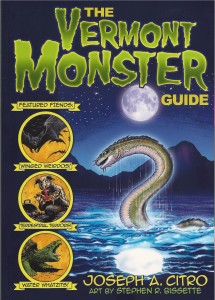
As mythology and urban legends attest, some of the greatest frisson when it comes to monster stories comes from attaching them to a particular landscape, the spookier and more remote, the better. Bissette and friend Joseph A. Citro started constructing geographical maps of Vermont’s own ghost tales, and then monster tales, which culminated in the publication THE VERMONT MONSTER GUIDE from University Press of New England. It features “fiends, winged weirdos, terrestrial terrors, and water whatzits”. If the cover seems playful, be prepared for a number of surprises lurking within its covers ready to pounce. Firstly, the table of contents arranges the Vermont-native beasties according to their elemental homes like a creepy medieval grimoire, giving the impression that the state is not safe by land, mountain, or sea, and add to that the chilling category “town”. Town?! But that’s only the first indication of the genuinely spooky stuff Citro and Bissette have catalogued. Then there are the names. They are disarmingly simple, and have that ring of folksy authenticity that makes a particular mark on the imagination: there’s “Pigman”, “Human-Faced Calf” and “Serpent of Dead Creek”. Shudder.
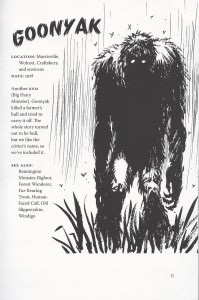
Maybe it’s the fact that these creatures are not easily identifiable within wider horror tradition. They have their own unique dwelling place in remote and rural imagination. The “Hopping Horror”, for instance, has a very specific haunt along “Route 7”, and is simply described as a “naked, hopping, man-like critter”. Honestly, that would be enough to freak me out on a dark autumn night, but Bissette’s illustrations conjure far more than your own imagination is likely to construct on its own. A personal favorite of mine is the “Man-Eating Stone”, which Citro explains is a rock which “becomes less solid, and like a living thing, swallows the unfortunate trespasser”. Bissette builds fear from the ground up by working with the familiar. The stone surface subtly shifts into glowering eyes and sprouts a tortured human arm reaching skyward in the wilderness. Bissette’s “stomach dwelling snakes” are not for the faint of heart, to say the least. I had to know more about this project that made me uneasy about road-trips from several states away, so I asked Bissette a couple of questions.
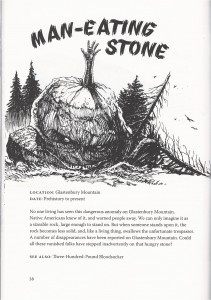
HM-S: What was the genesis of this book?
SB: I’ve been friends with the author, Joe Citro, for a couple of decades or more now. Joe is one of my best friends on planet Earth, that’s all there is to it. Sometime in the 1990s, we decided to “get into some foolishness,” as Joe calls it, and we self-produced and self-published the first version of a cartoon map of Vermont entitled VERMONT’S HAUNTS. I drew up a template map, Joe tagged where peculiar events had happened, and I illustrated the key “weird” sightings and events around the state, what would fit of them, and Joe wrote captions for them. We did pretty well with that, and every so many years we get a hankering to “get into some mischief” and work up another project. THE VERMONT GHOST GUIDE was one of those, which was published in 2000 and is still in print and selling well in and around our home state. THE VERMONT MONSTER GUIDE was our sequel/companion to that book. I pitched the book to our GHOST GUIDE publisher, University Press of New England, and got the best deal I could for Joe and I, and we got to work.
HM-S: Is there still a strong monster storytelling element up in Vermont?
SB: I wouldn’t have said or thought so, but since doing the book, I’ve been approached by more than one person or couple claiming to have seen “things” around Vermont. So I reckon there is.
HM-S: What did you most enjoy about illustrating the book?
SB: It was just a pleasure to draw, period. It was great working with the art director and team at UPNE, but nothing was as much fun as just drawing the creatures. It was a path to getting my own drawing chops back up to speed after a lengthy period in which I really didn’t do much drawing, save for my work in the classroom at the Center for Cartoon Studies.
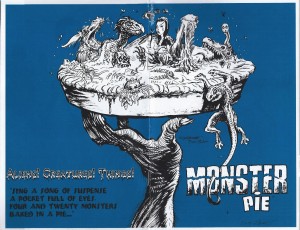
As unexpectedly frightening as THE VERMONT MONSTER GUIDE is, it works on the basis of a kind of subtlety that blends the urban legend with the uncanny. Bissette’s imagination runs wild on a very personal new project, an old-fashioned ‘zine called MONSTER PIE, created alongside Center for Cartoon Studies graduate Denis St. John. The indie monster ‘zine is a no-holds-barred freefall into the play of the darker side of the imagination, featuring illustration, short comics, and informative discussions about the horror genre. It’s inspiration lies in monster movies that both Bissette and St. John grew up with, and expresses with gusto their mutual enthusiasm for stretching the boundaries of horror illustration. Glancing through its pages proves the point that horror actually crosses genre boundaries regularly, from the folk-tale, to the sci-fi, to gothic tradition. A healthy does of mixing brings you the ingeniously “baked”, MONSTER PIE.
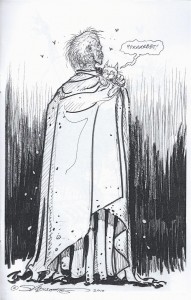
It packs a particular punch for this very reason: I’ve seen few mainstream or indie works that truly made me feel unsure of what lay beyond the next page. There’s a certain exhilaration in going off the map in this way, and as a ‘zine, it doesn’t have to follow the constraints of sequential narrative in doing so. That feature may, in fact, make it more spine-chilling than even THE VERMONT MONSTER GUIDE. You’ll find features of pulp sci-fi, literary horror tradition, and monster films that should be recognizable, but they are combined in sensory-twisting combinations and in widely differing art styles that both Bissette and St. John adopt. Bissette was kind enough to comment on MONSTER PIE and on his close collaboration with St. John. It still doesn’t explain how the two manage to bring the nether-reaches of the imagination to the page in such a fluid manner, but it does bring some new angles to the question.

HM-S: How did you and Dennis St. John get together on such a unique project?
SB: We would throw together these little monster minicomics for movie events—when we screened a double-bill of THE KILLER SHREWS (1959) and NIGHT OF THE LIVING DEAD (1968) for the Main Street Museum in White River Junction, VT a few summers ago, Denis, Tim Stout, and I did this little “Killer Shrew/Zombie Survival Guide” minicomic. This past summer, Denis and I did the same for a 35mm Saturday Fright Special (a Keene, NH-based cable-access horror host TV series) theatrical showing of the Chiodo Brothers’ KILLER KLOWNS FROM OUTER SPACE. We threw together, in a few days, a sick little book of ersatz parody poetry and monstrous clown sketches, and that was fun.
Cartoonists in Denis’s circle, including me, also contributed “pin-up” portraits of Denis’s characters in his serialized graphic novel AMELIA to his own comics zine MONSTERS & GIRLS over the past couple of years. AMELIA was Denis’s first expansive graphic novel, taking five years to complete, and major commitment, and he just finished it in the spring of 2012. He wasn’t sure what he wanted to tackle next, but he needed a breather, without stopping the flow of ink and drawings. That prompted me to suggest we just do our own free-form monster zine, mixing art, articles, and a smattering of comics in light enough combination to keep it from ever being anything but fun. No heavy lifting or content: just fun stuff. Denis was up for that.
This past Halloween, the Spooktacular folks screened a gorgeous 35mm print of the original British TALES FROM THE CRYPT (1972), based on the EC horror comics, so we got ambitious and did two zines for that event, and one of them was MONSTER PIE.
Denis goes way back with this stuff: he was part of a collective in his home state of Indiana called Atomic Age Cinema, another “horror host” live-monster-introduction-and-stage-act accompanying revivals of vintage public-domain horror, sf, and fantasy films. I met Denis when he was among my students at CCS, and we shared a lot of common interests. Denis graduated from CCS some years ago, and has made a commitment to the CCS community by sticking around, and we’re now colleagues and friends. So, MONSTER PIE is our way of keeping our hand in just drawing what we love to draw—movie monsters—for the sheer pleasure of it. I was the one who pushed to include zine features like the monster movie review and the archival monster movie article in each issue, and we’re going to keep doing MONSTER PIE until it’s not fun anymore, or our brushes give out.
HM-S: What can an old-fashioned ‘zine bring to readers today, as suffused as we are with digital content, corporate comics, and media-hyped magazines?
SB: Zine culture was part and parcel of my experience growing up; some of my first published artwork appeared in 1970s genre movie fanzines like CRYPT OF TERROR, JAPANESE FANTASY FILM JOURNAL, and Ted Rypel’s OUTER LIMITS fanzine, and I contributed a fair amount to comics zines of the late 1970s and early 1980s, too. Zine culture was also central to Denis’s generation, via other kinds of comics and media zines; CCS’s first Fellow who became a fellow instructor, Robyn Chapman, rekindled my own enthusiasm for zines of all kinds with her sheer passion for zines. Robyn’s love for zines was absolute and genuine, and fueled the whole CCS zine culture in many ways. CCS is a zine and comic factory in its own right, its incredible what comes out of the basement production lab on a monthly basis.
Zines just don’t go away. I’m started experimenting with ebooks, which I’ll be into in a major way in 2013 and 2014—I see that as an extension and mutation of zines, in a more expansive way. But there’s a tactile experience on both ends of the equation—the zine maker, and the zine reader—that digital media can’t supplant. I don’t get that from blogs or ebooks or online zines. There’s something about holding a zine in your hands, spending time with the physical object, that’s irreplaceable.
There’s also a purity and playfulness to zines that I love. However much work one pours into it, it IS play. The fact that there are no gatekeepers, save the access to a photocopier and enough money to print a few copies, remains a central attraction, too—and Denis and I have an entire production lab at our fingertips at CCS. We don’t need permission, we just need to be able to pay for the printing. Given all the gatekeepers corporate and mass culture erects and maintains between inspiration and publication, zines remain the personal steamroller over all of that—you think of it, you make it, you publish it, it’s in your hands. That’s still a real kick, in 2012.
A gargantuan “thank you” from The Beat goes out to Stephen Bissette for his insider view of monster-creating. Both THE VERMONT MONSTER GUIDE and MONSTER PIE are certainly a “kick” even in 2012, and for fans of the messy roots of horror tradition, they are two mileposts to look out for, particularly if you find yourself wandering in remote Vermont. After reading these, I don’t think I’ll venture up there without an armored vehicle. Just saying.
Hannah Means-Shannon writes and blogs about comics for TRIP CITY and Sequart.org and is currently working on books about Neil Gaiman and Alan Moore for Sequart. She is @hannahmenzies on Twitter and hannahmenziesblog on WordPress
BY JEN VAUGHN – Fantagraphics Books isn’t necessarily THE MAN of the comics world but since I’ve only ever self-published my own comics, MoCCA 2012 was my first two days on the job as a staff member of the independent comics publisher. There are more than a few differences between the two experiences. Read on!
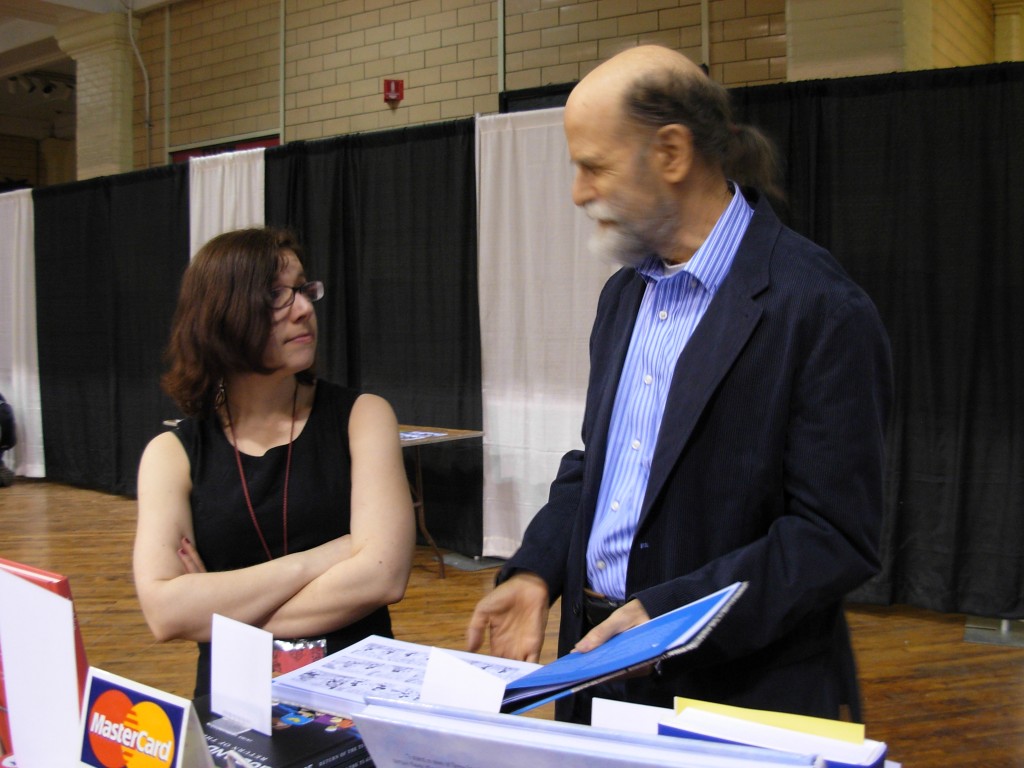
Fantagraphics’ Kristy Valenti speaks with Kim Deitch before his signing
1- The Work, as in amount of time spent working the table is constant. Seeing as there is a bit more marketing, publicity and established artists’ work on the table we rarely had to describe the content of the books. Jacq Cohen, Kristy Valenti and me (along with former intern Sophie Yanow) manned the four tables full of books and artists signings. Kristy and Jacq barely left the tables to eat and I’m pretty sure that bottle of lemonade under the table was not . . . lemonade.

2- The Digs where we stayed were MoCCA-recommended because they were smack-dab in the middle of Manhattan, right next to the Armory making for an easier walk each morning and night. The hotel room was tiny but the expansive lobby (pictured above) was an homage to both Breakfast at Tiffany’s and those plastic hamster balls. Originally built in 1903 and called the Martha Washington, this former women’s residence-turned-hotel was the perfect place for the woman of Fantagraphics to rest their heads. No long train rides in from Brooklyn this time!
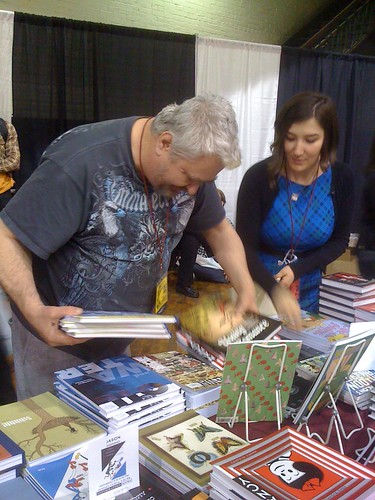
Daniel Johnston and Fantagraphics’ Jacq Cohen
3- Cross-promotion of artists turned out to be one of the joys. Some Fantagraphics artists spoke on panels (like the ever-charming Shannon Wheeler) so an attendee would grab his Oil & Water book but then toddle off in search of a signature at the Boom! Studios table where Wheeler was selling his Too Much Coffee Man. Likewise, folk artist/musician Daniel Johnston was too busy pouring over our new Nancy book to be bothered to remember what time his book signing was until Boom! editor Adam Staffaroni herded him in the right direction.
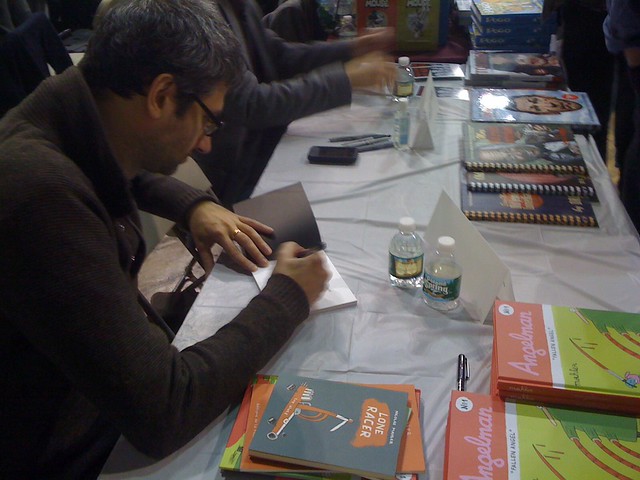
Nicolas Mahler signs not only his Fantagraphics book called Angelman but also previous publications bought from the Top Shelf table.
4- Table set-up and take down turned out to be an all-day

















It’s always great to see an interview with Mr. Bissette. BTW, his actual website is http://srbissette.com/
No one knows monsters like Steve!
MAN.EATING.STONE.
Finally got a chance to meet Steve (and the other “Swamp Thingers”) at the Cincinnati Comic Con a few months ago. Great, great guy. Great, great talent.